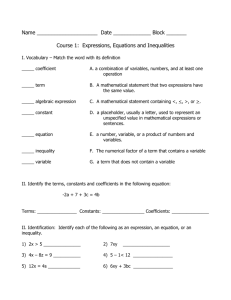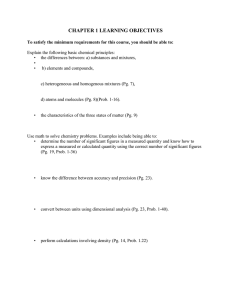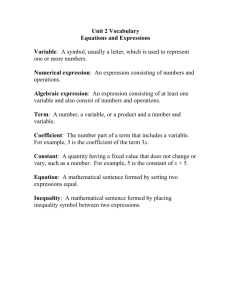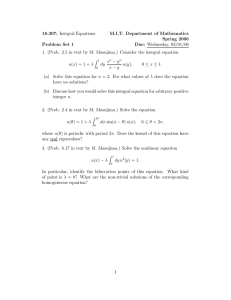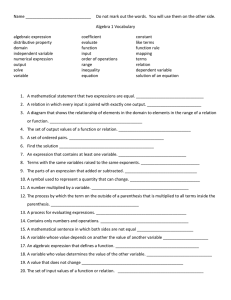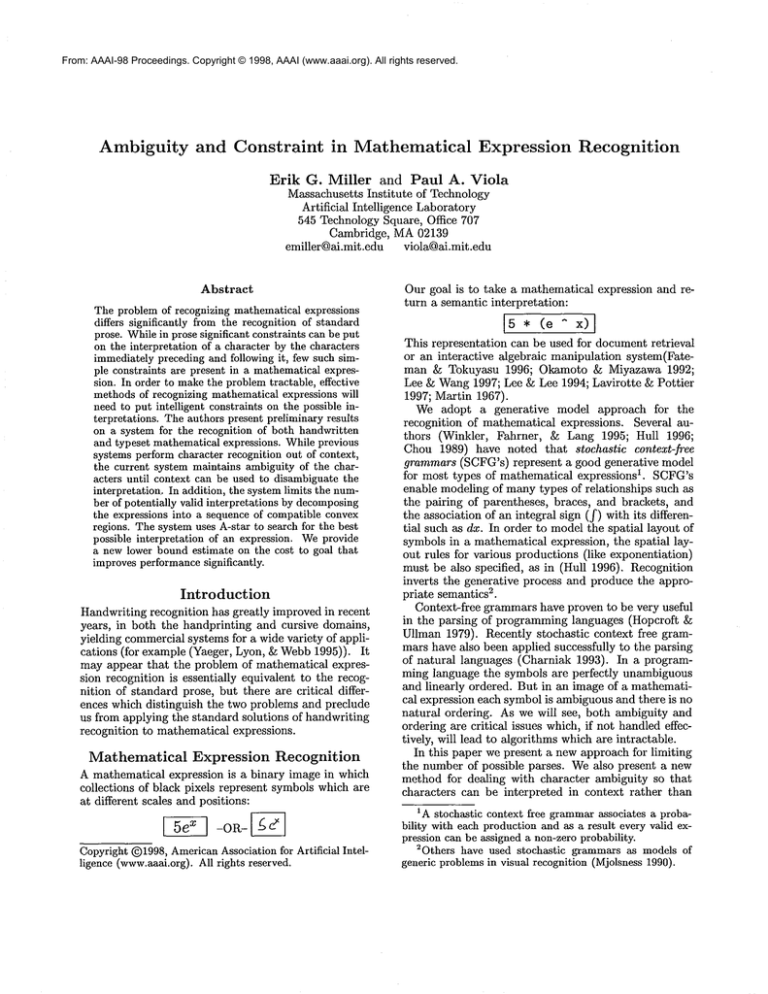
From: AAAI-98 Proceedings. Copyright © 1998, AAAI (www.aaai.org). All rights reserved.
Ambiguity
and Constraint
in Mathematical
Expression
Recognition
Erik
G. Miller
and Paul
A. Viola
Massachusetts Institute of Technology
Artificial Intelligence Laboratory
545 Technology Square, Office 707
Cambridge, MA 02139
emiller@ai.mit.edu
violaQai.mit.edu
Abstract
The problem of recognizing mathematical expressions
differs significantly from the recognition of standard
prose. While in prose significant constraints can be put
on the interpretation of a character by the characters
immediately preceding and following it, few such simple constraints are present in a mathematical expression. In order to makethe problem tractable, effective
methods of recognizing mathematical expressions will
need to put intelligent constraints on the possible interpretations. The authors present preliminary results
on a system for the recognition of both handwritten
and typeset mathematical expressions. While previous
systems perform character recognition out of context,
the current system maintains ambiguity of the characters until context can be used to disambiguate the
interpretatiom In addition, the system limits the number of potentially valid interpretations by decomposing
the expressions into a sequence of compatible convex
regions. The system uses A-star to search for the best
possible interpretation of an expression. We provide
a new lower bound estimate on the cost to goal that
improves performance significantly.
Introduction
Handwriting recognition has greatly improved in recent
years, in both the handprinting and cursive domains,
yielding commercial systems for a wide variety of applications (for example (Yaeger, Lyon, & Webb1995)).
may appear that the problem of mathematical expression recognition is essentially equivalent to the recognition of standard prose, but there are critical differences which distinguish the two problems and preclude
us from applying the standard solutions of handwriting
recognition to mathematical expressions.
Mathematical
Expression
Recognition
A mathematical expression is a binary image in which
collections of black pixels represent symbols which are
at different scales and positions:
Copyright @1998,AmericanAssociation for Artificial
ligence (www.aaai.org). All rights reserved.
Intel-
Our goal is to take a mathematical expression
turn a semantic interpretation:
and re-
12 * (e x)]
This representation can be used for document retrieval
or an interactive
algebraic manipulation system(Fateman & Tokuyasu 1996; Okamoto & Miyazawa 1992;
Lee & Wang 1997; Lee & Lee 1994; Lavirotte & Pottier
1997; Martin 1967).
We adopt a generative
model approach for the
recognition of mathematical expressions.
Several authors (Winkler, Fahrner, & Lang 1995; Hull 1996;
Chou 1989) have noted that stochastic
context-free
grammars (SCFG’s) represent a good generative model
for most types of mathematical expressions I. SCFG’s
enable modeling of many types of relationships
such as
the pairing of parentheses, braces, and brackets, and
the association of an integral sign (f) with its differential such as dx. In order to model the spatial layout of
symbols in a mathematical expression, the spatial layout rules for various productions (like exponentiation)
must be also specified, as in (Hull 1996). Recognition
inverts the generative process and produce the appro2.
priate semantics
Context-free grammars have proven to be very useful
in the parsing of programming languages (Hopcroft
Ullman 1979). Recently stochastic context free grammars have also been applied successfully to the parsing
of natural languages (Charniak 1993). In a programming language the symbols are perfectly unambiguous
and linearly ordered. But in an image of a mathematical expression each symbol is ambiguous and there is no
natural ordering. As we will see, both ambiguity and
ordering are critical issues which, if not handled effectively, will lead to algorithms which are intractable.
In this paper we present a new approach for limiting
the number of possible parses. We also present a new
method for dealing with character ambiguity so that
characters can be interpreted
in context rather than
1A stochastic context free grammar associates a probability with each production and as a result every valid expression can be assigned a non-zero probability.
2Others have used stochastic grammars as models of
generic problems in visual recognition (Mjolsness 1990).
in isolation, and so that no probability threshold must
be applied in the character recognition process. The
search for the most likely interpretation is performed
using A-star search (following the workof (Hull 1996)).
Wepropose a new underestimate to the goal that significantly reduces computation time.
Polynomial
Time Parsing
The parsing of programming languages is a solved
problem. The Cocke-Younger-Kasami (CYK) algorithm (Hopcroft & Ullman 1979), a dynamic programming algorithm, is cubic in the number of characters.
The first step of CYKis to build a table (or "chart")
with one entry for every sub-sequence of symbols. Each
sub-sequence can be indexed by its starting symbol, a
number between 1 and N, and its ending symbol,
also
2N
between 1 and N. There are approximately -~ such
entries. The algorithm then attempts to find the most
likely interpretation for each sub-sequence, an inherently recursive process in which the interpretation of
a long sequence is dependent on the interpretation of
shorter constituent sub-sequences. The key to computational efficiency is the observation that a particular
sub-sequencewill be the constituent of manylarger subsequences, yet the computation need only be done once.
The computational efficiency afforded by the CYK
algorithm depends on the existence of a decomposition
of the problem into a polynomial numberof unique subproblems. This polynomial nature is a direct result of
the linear ordering of text. If such a linear sequenceexists we can with impunity limit the set of sub-problems
to the set of all consecutive sub-sequences of characters. Mathematical expressions, which are collections
of symbols arranged in two dimensions, do not have a
straightforward decomposition into a polynomial number of subsets.
Take for example the expression shown in Figure 1.
Written out in Matlab syntax, which relies on a linear
ordering of symbols, it wouldbe "e ^ x * (A / B)".
the linear form we can conclude that ’x’ is part of the
exponential because it is separated from the fraction
by a parenthesis. In the graphical form ’x’ is equally
close to the ’A’ and the ’e’. There is almost no local
information from which we can conclude attachment.
In this case we must rely on contextual information, in
the form of a graphical SCFG,to make the attachment.
Like CYKparsing, in order to find the best possible
parse of a mathematical expression we must enumerate
all possible subsets of symbols.Since there is no simple
linear constraint we must find some other constraints
on the numberof allowable subsets. Other authors have
dealt with this issue in several ways.
Rectilinear
mathematical expressions
Chou (Chou 1989) presents a system in which expressions are represented as rectangular arrays of terminal
symbols. He limits the numberof potential parses dramatically by requiring that the baselines of characters
Figure 1: A simple expression which is difficult to decomposeinto a small number of subsets.
be within one pixel of their expected location. While
this workswell for the simulated data presented, it cannot be expected to extend to handwritten input, since
the variation in handwritten input is frequently more
than a pixel.
A recognizer
with moderate positional
flexibility
Winkler et al. (Winkler, Fahrner, & Lang 1995) describe a more flexible system in which two subexpressions can be considered as part of a larger expression
as long as the second expression is within certain predefined regions relative to the first expression. However,
this system imposes severe limits on the distance which
a symbol can be from another symbol while still being
part of a commonsubexpression. Wewish to avoid this
type of limit, as webelieve it will rule out the true answer in some situations. This system also decides on
characters out of context, which has problems that are
discussed below.
Modeling positions
of characters as
Gaussian variables
Hull (Hull 1996) comescloser to our desired goal, by allowing more general positioning of terminals and subexpressions relative to each other. The probability that
two subexpressionsare in a particular relationship relative to each other (e.g. one is the subscript of the other)
is defined by a two dimensional Ganssian distribution
around the expected position of the second expression.
Hence, the further the second expression is from the
center of the Gaussian defining that relationship, the
lower the probability of that particular operation.
Withthis more flexible modelof character positions,
there are no rigid geometric constraints which can be
used to automatically prune awaythe exponential number of symbol subsets. Instead Hull’s algorithm attempts to enumerate all possible subsets, and prunes
awaythose that are very unlikely. Because of the potentiaily exponential number of subsets, Hull uses Astar search to order the enumeration of subsets. Our
implementation also uses an implementation of A-star
search, explained below.
A-Star Search A-star search is similar to best-first
search, but in addition requires that one produce an underestimate of the "distance" to the goal (a full parse)
from a given sub-parse. To apply A-star in a proba-
b2 +b3
b2,
+b3
.-’."
A+B+C ,~-g-B+C
Figure 2: An expression where convex hulls are useful
for pruning interpretations. Note that the probability
that the enclosed characters are in fact the expression
Az is reasonable. But this subset is eliminated because
their convexhull intersects the fraction symbol.
bilistic setting, one conventionallyuses the negative log
likelihood as the notion of distance. The probability
of an interpretation of an image is the product of the
unconditional terminal probabilities multiplied by the
probabilities which stem from the geometry rules. The
unconditional terminal probabilities are an underestimate of the cost to achieve the final goal - an interpretation of the entire image. This underestimate is added
to the negative log likelihood of a sub-parse in order to
evaluate whether the sub-parse is a good candidate for
expansion.
Wecompute the A-star estimate by accumulating
maximum
likelihood estimates of the terminals. Hence,
the A-star penalty is computedas:
~min (- In Pr (c = t))
cE¢
tET
where C is the set of uninterpreted connected components (terminals) and 7- represents all possible characters in the grammar.
Convex Hulls: A new pruning criterion
As a second method for pruning the search space of
parses, we attempt to prune away possible subsets
based on a simple geometric test: a subset of characters
is not allowed if the convexhull of the subset contains
a character that is not part of the subset3. Wedefine
the convexhull of the character to be the smallest convex polygonthat contains all of the pixels which define
the character (for handwritten text the convex hull is
the smallest convex polygon which contains all of the
strokes defining the character). The convex hull of
set of characters is the convexhull of the union of the
convexhulls of each character in the set (see Figure 2).
Thereare several justifications for this criterion:
* It is consistent with the layout rules for typeset expressions and is not violated for any of our test data.
In fact, we are unaware of a typeset expression for
whichthe constraint is violated.
¯ For linear text this criteria is identical to the constraint that subsets must contain consecutive symbols. Any non-consecutive subset will have a convex
hull that contains a character whichis not in the set.
3This rigid rule could be converted to a soft
in our probabilistic framework.
constraint
¯ The algorithms necessary for computing with convex
hulls are very efficient. A convexhull of a point set
can be computed in O(nlogn), where n is the number of points (Cormen, Leiserson, & Rivest 1991).
Computingthe convex hull union of two convex hulls
is O(m+ l), where l and mare the numberof vertices
in the convex hulls. The intersection of two convex
hulls can be found in O(m+ l) also.
Unfortunatelyit is possible to construct an artificial
arrangement of two dimensional symbols for which this
criterion yields no pruning4. But, for manytwo dimen3
sional mathematical expressions there are roughly N
allowable subsets.
Furthermore, somevalid expressions violate the convex hull rule described above. This could be at
least partially remedied by eroding characters a small
amount before the convex hull test is performed. The
preliminary convex hull results are encouraging (See
Figure 8).
Maintaining ambiguity of character
identification
In addition to dealing with all of the possible arrangements of symbols and deducing the operations based on
relative positions, we must tackle the problemof disambiguating individual characters. As already suggested,
ambiguity makes recognition of the whole expression
difficult. Wecategorize the problems caused by ambiguity into three groups.
The first we call the "q-9" problem, and it is illustrated in Figure 3. There are pairs of characters which
are, without context, impossible to distinguish. Accurate recognition requires that multiple character hypotheses be maintained until the ambiguity can be resolved from context. There are many examples of confusable characters, even whenthe characters are written quite carefully. For sloppily handwritten text the
overlap amongcharacter classes becomesquite large.
The second type of problem caused by ambiguity we
call the "threshold problem". This is illustrated in Figure 4. It shows an example of a situation in which
the constraints provided by the grammarcould allow
us to successfully interpret the ’+’, even though out
of context, it would appear extremely unlikely to be a
’+’. Any system which discards hypotheses based on a
probability threshold runs the risk of missing a correct
recognition in such cases.
The third type of problem arising from ambiguity is
"interpretation explosion". Whenmultiple hypotheses
are maintained for a single character the numberof possible parses grows rapidly. For example, the geometric
measures of grammar classes such as "exponentiation
expression" depend upon the baseline of the base of the
exponent. Whenwe maintain ambiguity in the individual characters we must also maintain ambiguity in these
aTakea set of very small symbolsarrangeduniformlyon
the circumferenceof a very large circle. The convexhull of
everypossible subset of symbolsis allowable.
q
A
B
9
c
Figure 3: A. The isolated analysis of a character has
inherent ambiguities which cannot be resolved without
context. B. Clearly the context here suggests that the
character is the letter ’q’. C. The context in this figure
suggests the characteris the digit ’9’.
dependent higher level classes. This causes the size of
the grammarto grow by a factor which is roughly equal
to the numberof character classes for which we maintain ambiguity. This can make the grammar impractically large. Below, we discuss a compromisebetween
committingto a character out of context (to be avoided)
and maintaining all possible character hypotheses during the parsing process (too complex).
Returning for a momentto previous work, we note
that Hull performs a pre-processing step that recognizes
each of the characters in the expression. Because this
recognition takes place before parsing, it does not make
use of available contextual information. He is thus vulnerable to the "q-9" problem discussed above.
The following simple analysis demonstrates the necessity of maintaining multiple character hypotheses in
developing a robust system. Suppose we have a system
for whichisolated character recognition is correct with
probability R. If an expression consists of t characters,
we have probability Rt of correctly recognizing all of
the characters without contextual information. With
R = 0.95 and t = 20, we obtain a surprisingly low
probability, 0.9520 ~, 0.36, of getting every character
right. This is an upper bound on the probability we
will correctly parse the entire expression(it is possible
that the parse might fail for other reasons). Obviously,
this upper boundwill only shrink if we recognize larger
expressions or allow a more varied set of characters.
The system described in (Chou 1989) maintains ambiguity, but in a limited sense. For each character it
retains only those interpretations whichare abovea certain likelihood. His character models are Gaussian; he
proposes a threshold at three standard deviations from
the mean. While this may seem like a conservative
threshold, a similar analysis shows that in a 20 character expression, on average one correct character will
be eliminated for more than 5 percent of expressions,
since 1 - 99.7420 ~ 0.0507. Also, this schememaylead
to keeping around large numberof character hypotheses
in handwriting recognition, where the characters have
large variations.
Figure 4: An exampleof an expression with a very noisy
character. The ’+’ is very difficult to interpret correctly
without the context, but with constraints provided by
the grammarcould potentially be correctly identified.
A Compromise: Maintaining
a Hypothesis
for
Each Character Class Many of the terminals in our
grammarare in the same syntactic class. As a result
a grammatical analysis can never resolve ambiguity between them. So for example if a character is slightly
morelikely to be a ’b’ than an ’h’ there is no syntactic
information that can resolve this ambiguity5. Wecan
save a lot of effort by simplydeciding at the outset that
the terminal is a ’b’. On the other hand, as we saw in
Figure 4 the ambiguity in the central symbol can be
resolved through syntactical analysis. In this case it is
important that multiple hypotheses be maintained.
As a middle ground, between maintaining hypotheses
for all possible terminal symbols and committingto the
single most likely character, we define classes of characters which play the same syntactic role in the grammar.
Since the characters in these classes are grammatically
equivalent, no constraint from the SCFGcan ever be
used to disambiguate membersof the class. Only the
single most likely interpretation for each syntactic class
need be maintained.
The concept of syntactic class must be expanded to
account for the fact that characters which are traditionally considered syntactically equivalent (like ’p’ and
’P’) maybehave differently with respect to the geometric aspects of the grammar. An exaznple is shown in
Figure 5, where the most likely out o/context interpretation of the leftmost character is lowercase ’p’. There
is no advantage in maintaining the hypothesis that the
character is a ’q’; it has low probability and all of the
important spatial properties of the glyph as a ’p’ (its
baseline, for example)are the sameas if it were a ’q’.
This is not true for the interpretation as a ’P’ however,
since the baseline under this interpretation would be
higher. Andin this case, it turns out that the most
likely context-dependent interpretation is as a ’P’, not
as a ’p’.
This leads to/our terminal classes of letters (a single
class traditionally) for which we maintain hypotheses
throughout the interpretation process. These classes
are ascending letters, descendingletters, small letters
(neither ascending nor descending), and large letters
(both ascending and descending). "P", "p", "e", and
"Q" represent examples from each respective class.
Other authors have used similar classes but not to
5Other forms of contextual information might be useful
for this sort of problem.Weaxe currently exploring this
possibility.
¯ ascender/descenders: f, j, Q,/~,
¯ binary operators:
Figure 5: The first character (a "p" or a "P"?) can
only be resolved by considering its relationship to the
subsequent character.
maintain different classification hypotheses (Winkler,
Fahrner, & Lang 1995).
In addition to these separate letter classes which
are based strictly on their geometric properties, other
classes were defined based on their non-spatial role in
the grammar. For example, other syntactic terminal
classes include: "zero", non-zero digits, left parentheses, right parentheses, and fractions. Each of these
plays a distinctively different role in the grammarof
a mathematical expression. In all, a separate hypothesis for each of the 14 different terminal classes is maintained.
A New Approach
Hence, our approach contains three innovations. The
first is the geometric convexhull constraint, which limits the growth of the numberof possible parses of the
expression. The secondis a new(but still conservative)
A-star completion estimate. The third is the bookkeeping necessary to maintain an hypothesis for each character class, which allows us to interpret individual characters using greater contextual information. Wenow
describe some implementation details of a preliminary
system.
Implementation
Certain assumptions were made in order to get a preliminary system working. In the typeset version of the
system, it is assumedthat all characters are distinct
and do not overlap. Wemake no attempt to deal with
scanner distortion. In fact, all of the typeset examples
in this paper were generated on-line and are essentially
distortion-free.
Overview
The typeset system takes a binary image as input. A
simple connected components algorithm is run on the
image, generating a list of terminals. A character recognizer based on the Hausdorff distance (Huttenlocher,
Klanderman, &: Rucklidge 1993) is used to generate
probabilities that each connected componentor pair of
connected components is a particular character. The
set of terminals for the initial system is, according to
class:
¯ ascenderletters: b, d, h, i, k, l, t, ~, A-Z(except Q),
¯ descenderletters: g, p, q, y, %
¯ smallletters: a, c, e, m,n, o, r, s, u, v, w,x, z, a,
+,-,=,
¯ zero: 0,
¯ non-zero digits: 1-9,
¯ other symbols(each its ownclass): (,), [, ], {, }, fraction symbol.
While the grammaris muchtoo large to include here
(80 classes, 200 productions), it is worth mentioningthe
following:
¯ It is represented in ChomskyNormal Form. This
facilitates the coding of the grammar.
¯ It contains productions supporting exponentiation,
subscripting, fractions, "loose" concatenation (multiplication), and "tight" concatenation (the appending
of digits in a number).
¯ The a priori probability of each operation is the same.
Probabilities of operations are assigned only according to the geometryof the layout and the probability
of their sub-parses.
After the programhas calculated the probability of
each character being in each class, the program starts
the dynamic programmingprocess which is closely related to the CYKalgorithm mentioned before. The
first step in this process is to build the previously mentioned "table" in which there is one entry for every subsequence of characters. This can be done in order from
the shorter sequences to the longer sequences, by first
computing the probability of each sequence of length
1, then from these computing the probability of each
sequence of length 2, and so on.
In our implementation, we limit the size of the parse
table using a very conservative restriction on the distance betweensub-sequencesas an initial filter and the
convex hull criterion described previously as a second
filter. Whenwe finish building the table, the entry
which has the full number of characters and the highest probability represents the best legal parse of the
given mathematical expression.
Building the Table
Figure 6 shows how the parse table is generated for a
sample mathematical expression show in Figure 7. The
table contains one columnfor each subset of terminals,
and one row for each possible interpretation for that
subset. The input to the parsing algorithm is a set of
connected components. Associated with each component is a probability vector, containing the conditional
probability for each possible terminal symbol.As a first
step only the most likely terminal from each syntactic
class is retained. For example,the most likely interpretation for the leftmost componentis as an ’a’. Nevertheless several other hypotheses are maintained: as an
ascender it is most likely to be an ’O’; as a descender
it is most likely to be a ’q’; as an ascender/descender
Trmnl
Global
properties of the connected
component set
As a small
ter
let-
As a large letter
As a digit
As an exponentiation
As subscript
1
Trmnl
2
Trmnl
3
Trmnls
1,2
Trmnls 2,3
Trmnls 1-3
Min x, max x,
min y, max y,
centroid
Minx, maxx,
min y, max y,
centroid
Min x, max x,
min y, max y,
centroid
Min x, max x,
min y, max y,
centroid
Min x, max x,
min y, max y,
centroid
Min x, max x,
min y, max y,
centroid
Prob: 0.1
Baseline: 47
Pt-size: 12
Prob: 0.05
Baseline: 55
Pt-size: 13
Prob: 0.05
Baseline: 52
Pt-size: i0
Prob: 0.0
Baseline: 0.0
Pt-size: 0.0
Prob: 0.0
Baseline: 0.0
Pt-size: 0.0
Prob: 0.0
Baseline: 0.0
Pt-size: 0.0
Prob: 0.01
Baseline: 45
Pt-size: 8
Prob: 0.02
Baseline: 53
Pt-size: 9
Prob: 0.01
Baseline: 50
Pt-size: 9
Prob: 0.0
Baseline: 0.0
Pt-size: 0.0
Prob: 0.0
Baseline: 0.0
Pt-size: 0.0
Prob: 0.0
Baseline: 0.0
Pt-size: 0.0
Prob: 0.03
Baseline: 47
Pt-size: 9
Prob: 0.02
Baseline: 55
Pt-size: 11
Prob: 0.01
Baseline: 52
Pt-size: 11
Prob: 0.0
Baseline: 0.0
Pt-size: 0.0
Prob: 0.0
Baseline: 0.0
Pt-size: 0.0
Prob: 0.0
Baseline: 0.0
Pt-size: 0.0
Prob: 0.0
Baseline: 0.0
Pt-size: 0.0
Prob: 0.0
Baseline: 0.0
Pt-size: 0.0
Prob: 0.0
Baseline: 0.0
Pt-size: 0.0
Prob: 0.001
Baseline: 47
Pt-size: 12
Prob: 0.00007
Baseline: 55
Pt-size: 13
Prob: 0.0003
Baseline: 47
Pt-size: 12
Prob: 0.0
Baseline: 0.0
Pt-size: 0.0
Prob: 0.0
Baseline: 0.0
Pt-size: 0.0
Prob: 0.0
Baseline: 0.0
Pt-size: 0.0
Prob: 0.00005
Baseline: 47
Pt-size: 12
Prob: 0.002
Baseline: 55
Pt-size: 13
Prob:
0.00000043
Baseline: 47
Pt-size: 12
Figure 6: Part of a parse table used to do dynamic programming.
it is most likely to be a ,Q,6, and so on. In addition to computingthese probabilities, we compute certain interpretation-dependent quantities of the characters such as the baseline and the point size. They are
interpretation-dependent since they are different for different rows of the table. Finally, we also computeglobal
properties of the current connected componentgroup.
These properties include the minimumand maximum
coordinates, the centroid, the convexhull, and so forth.
These global properties only need to be computedonce
per connected componentgroup, since they are invariant to the interpretation of the group.
In addition to the terminal classes there are rows in
the table for compoundexpressions made up of multiple terminals (e.g. exponentiation, fractions, binary
operations, etc.) There is zero probability that these
expressions can generate an output with a single component.
The initial state of the system is shownin the first
three columnsof the table. There is one entry for each
distinct componentin the image. Parsing is a process
by which new columns are added to the table, each
describing a valid subset of componentsfrom the original image. The table is expanded toward the right,
as large collections of componentsare enumerated and
evaluated.
There are three possible two-character combinations
8Thisis a veryunlikelyhypothesis,but it is the best in
thatclass.
bd
Figure 7: The sample mathematical expression used in
the description of table building. Notice that no entry
was made in the table for the two-character combination of characters "a" and "d". This is because the a-d
pair do not fit the convexhull criterion.
of the three characters. However,if the two characters
fail the convex hull test described above, as with the
"a" and the "d" in our example, then an entry in the
table will not be made. Since the two componentgroups
cannot be interpreted as a single terminal, these rows
axe flagged as impossible. As new columns are added
to the table, the interpretation-dependent and global
properties of the group are computed.
The final column in the table shows probabilities
of interpretations of the entire expression. Column6
showsthat the correct interpretation (as an exponentiation at the highest level) has the highest probability,
so in this case the procedure workedproperly.
Convex Hull Constraint
14o0’ ¯ ¯ i ¯ . . n¯ - ¯ , ¯ ¯ ¯ , , ¯ ¯ ,i. ¯ ¯
/
/~
1200 ~ mithout constraint
1/
O with constraint
i000
/
Experiments
To verify the basic functionality of the system, we performed a simple series of tests. For each letter x in
the system, the following expressions were used as inputs to the system: x~, x~, x~=, ~. Where allowed by
the grammar,the digits were also used in these tests.
All of these test images were evaluated correctly by the
system.
Weattempted to evaluate the effectiveness both of
the the convex hull pruning constraint and A-star
search using our underestimate of the distance to goal.
Withoutusing either type of heuristic, parse times were
very long - on the order of minutes. Using both criteria parse times are in the seconds. In order to quantify
this we created a series of expressions of varying complexity from 3 terminals to 20 terminals. Onthe left of
Figure 8 is the performance of the A-star system with
and without the convexhull constraint. Onthe right is
the performance using the convex hull constraint with
and without the A-star heuristic 7 . There is significant improvementin performance using either of these
heuristics, and even greater improvement when both
are used. Wecollected data from the system running
without either heuristic, but this curve quickly exists
the top of the graph.
It is interesting to note howthe system performed on
"illegal" images, for examplethe expression 0°°. This
input is considered illegal since our grammarprovided
no mechanism for subscripting a number. As a result the system recognized the input as the expression
"600". This can be understood as follows: since the system could not generate 0o, it apparently concluded that
the last two zeroes were effectively the samesize. However, the output 0°° would also be illegal since a two
digit number cannot begin with a 0. The system’s fix
was to consider all three digits as being approximately
the same size, and then using a muchless likely, but
legal interpretation of the first digit, it settled on "600"
as the best interpretation. This exampleillustrates a
good deal about the system’s flexibility in generating
reasonable answers in tough situations.
Anecdotal examples of expressions which the system
successfully parsed are given in Figure 9. The actual
time spent parsing these expressions on a 266MHz
Pentium Pro was approximately 4, 0.2, 16, and 25 seconds.
This does not include the time to generate character hypotheses for the connected components. These examples are not difficult, but they validate the basic method
and show that it is feasible to do the extra bookkeeping which we have incorporated in this system. The
only failures in the current typeset system were due to
mis-recognition of characters.
7Thepoints on the two graphs are the same set of expressions, the graphon the left contains fewerpoints because
the computationtime for A-star without convexhull pruning growsfar too rapidly for us to measure.Wesimplygave
up after manyminutes of run time.
aoo
~
e110
400
/
. ..-’"
_..-’"0
/ ,0"
EO0
~ o-- ’"
. ~- ~ .~’o
o ,,,n .......
,..,,,..,...
2
4 6 /e 1o
12
Characters
in/ Expression
.
5000 ....
A-star Constraint
, ....
* ....
i ....
.
~( withoutconstralnt
with constraint
f~i
/
= 4000
3000
/
//
2000
/
/
!
//
.--’3"
~
tooo
..-"
ft. ~..-~.o- " o
~.~,r~-~.
............
5
to
15
Charaete~in Expression
-¢
20
Figure 8: The left graph showsthe pruning of the search
space by the convex hull criterion. The right graph
shows the performance gained by adding the A-star
constraint. The algorithm reduces to best-first search
without the A-star constraint.
5a +o
k~+ 2
e6 + Z7
123
2
4567 + a+K+Cd
Figure 9: Someof the expressions successfully recognized by the system.
Future
Work
A major focus in developing this system was to prepare for the migration to handwritten mathematical
expressions. Our preliminary work with handwritten
expressions is illustrated in Figure 10. Weshowthree
examples, the first of which was parsed correctly, the
second of which contains a geometry-based error, and
the third of which contains a character-identification
error. Wehope that by improving the character recognizer and learning the parameters of our geometry
models that we can significantly improve the performanceof the system in the future. While the accuracy
of the current system needs great improvement,we feel
we have laid the groundworkfor a practical system’s
implementation.
Acknowledgments
Wewould like to thank TomRikert and Nicholas Matsakis for contributions and discussions related to this
work.
References
Charniak, E. 1993. Statistical Language Learning.
Cambridge, MA:MIT Press.
Chou, P. A. 1989. Recognition of equations using a
two-dimensional stochastic context-free grammar. In
I
-51
t+a+v
Figure 10: Someexamples of handwriting and their
parses.
SPIE Vol. 1199 Visual Communications and Image
Processing, SPIE, 852-863. MurrayHill, N J: SPIE.
Cormen, T. H.; Leiserson, C. E.; and Rivest, R. L.
1991. Introduction to Algorithms. Cambridge, Mass.:
MITPress.
Fateman, R. J., and Tokuyasu, T. 1996. Progress in
recognizing typeset mathematics. In DocumentRecognition III, SPIE Volume2660, 37-50. MurrayHill, N J:
SPIE.
Hopcroft, J. E., and Ullman, J. D. 1979. Introduction to Automata Theory, Languages, and Computation. Reading, Mass.: Addison-Wesley.
Hull, J. F. 1996. Recognition of mathematics using a
two-dimensional trainable context-free grammar. Master’s thesis, MassachusettsInstitute of Technology,Department of Electrical Engineering and ComputerScience.
Huttenlocher, D. P.; Klanderman, G. A.; and Rucklidge, W. J. 1993. Comparingimages using the hausdorff distance. IEEETransactions on Pattern Analysis
and MachineIntelligence 15(9):850-863.
Lavirotte, S., and Pottier, L. 1997. Optical formula recognition. In Fourth International Conference
on DocumentAnalysis and Recognition, ICDAR,357361. Ulm, Germany: IEEE.
Lee, H.-J., and Lee, M.-C. 1994. Understanding mathematical expressions using procedure-oriented transformation. Pattern Recognition 27(3):447--457.
Lee, H.-J., and Wang, J.-S. 1997. Design of a mathematical expression understanding system. Pattern
Recognition Letters 18:289-298.
Martin, W. A. 1967. A fast parsing scheme for
hand-printed mathematical expressions.
MIT AI
Project Memo145, Massachusetts Institute of Technology, Computer Science Department, MIT, Cambridge, MA.
Mjolsness, E. 1990. Bayesian inference on visual grammars by neural nets that optimize. Technical Report
854, Yale University, Department of Computer Sci-
ence, ComputerScience Department, Yale University,
New Haven, CT.
Okamoto, M., and Miyazawa, A. 1992. An experimental implementation of a document recognition
system for papers containing mathematical expressions. In Baird, H. S.; Bunke, H.; and Yamamoto,
K., eds., Structured DocumentImage Analysis. Berlin:
Springer-Verlag. 36-63.
Winkler, H. J.; Fahrner, H.; and Lang, M. 1995. A
soft-decision approach for structural analysis of handwritten mathematical expressions. In International
Conference on Acoustics, Speech, and Signal Processing.
Yaeger, L.; Lyon, R.; and Webb, B. 1995. Effective training of a neural networkcharacter classifier
for word recognition. In Mozer, M.; Jordan, M.;
and Petsche, T., eds., Advances in Neural Information Processing, volume 9. Denver 1996: MITPress,
Cambridge.

